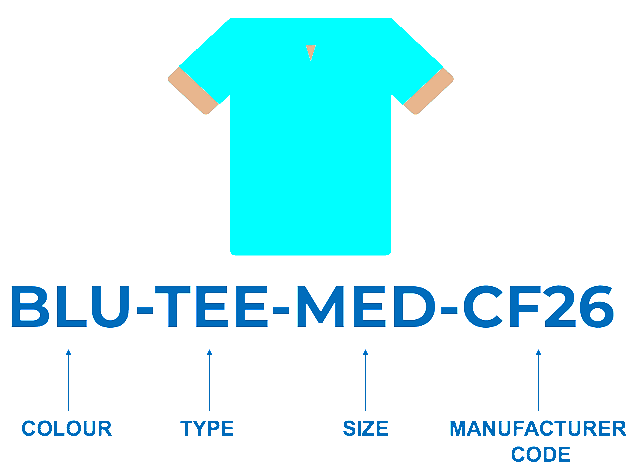Best Practices to Create SKU Numbers for Online Sellers
Creating effective SKU (Stock Keeping Unit) numbers is crucial for any online seller. SKUs help manage inventory, track products, and streamline the sales process. This blog will guide you through the best practices for creating SKU numbers that enhance your e-commerce operations.
What is an SKU?
An SKU is a unique identifier for each product in your inventory. It’s used internally to track stock levels, manage orders, and analyze sales. Unlike barcodes, which are standardized across industries, SKUs are created by businesses to fit their specific needs.

Why Are SKUs Important?
- Inventory Management: SKUs help keep track of stock levels, making it easier to reorder products before they run out.
- Order Fulfillment: Accurate SKUs ensure that the correct products are picked, packed, and shipped.
- Sales Analysis: SKUs enable detailed sales reporting and analysis, helping you understand product performance.
- Customer Service: Quick SKU identification helps resolve customer inquiries and returns efficiently.
Best Practices for Creating SKU Numbers for Online Sellers
1. Keep it Simple and Consistent
- Standard Format: Use a standard format for all SKUs to maintain consistency. This could be a combination of letters and numbers, such as “ABC123.”
- Length: Keep SKUs relatively short, ideally between 8 to 12 characters. Avoid overly complex codes that are hard to remember or prone to errors.
2. Use Meaningful Characters
- Descriptive Codes: Incorporate meaningful information into your SKUs, such as product category, color, size, or model. For example, a black medium-sized T-shirt could be “TSH-BLK-M.”
- Avoid Confusing Characters: Avoid using characters that can be easily confused, such as “0” (zero) and “O” (letter O), or “1” (one) and “I” (letter I).
3. Segment Your SKU
- Components: Break your SKU into segments that represent different product attributes. For instance, the first three characters could indicate the product category, the next two the color, and the final two the size.
- Example: For a large red shirt, the SKU might be “SHI-RED-L.”
4. Avoid Special Characters and Spaces
- Use Hyphens or Underscores: Instead of spaces, use hyphens (-) or underscores (_) to separate different segments of the SKU. This improves readability and compatibility with various systems.
- No Special Characters: Avoid using special characters like “#,” “@,” or “&,” as they can cause issues in some inventory management systems.
5. Ensure Scalability
- Future-Proofing: Design SKUs that can accommodate future product additions. Leave room for growth in each segment of your SKU structure.
- Example: If you start with “SHI-RED-L” for large red shirts, ensure you can expand to “SHI-BLU-XL” for extra-large blue shirts.
6. Unique for Each Product
- Uniqueness: Ensure that each SKU is unique to prevent confusion in inventory management and order fulfillment. Duplicate SKUs can lead to errors and inefficiencies.
7. Test Before Implementation
- Simulation: Before finalizing your SKU system, test it with a sample of your products to ensure it works effectively and is easy to use.
- Feedback: Get feedback from your team to identify any potential issues or improvements.
8. Document Your SKU System
- Guidelines: Create a detailed document outlining your SKU creation process and rules. This helps maintain consistency as your team grows.
- Training: Train your staff on the SKU system to ensure everyone understands how to create and use SKUs correctly.
Example of a Good SKU Numbers System
For an online clothing store, your SKU structure might look like this:
- Category: SHI (Shirt), PAN (Pants), JAC (Jacket)
- Color: BLK (Black), RED (Red), BLU (Blue)
- Size: S (Small), M (Medium), L (Large), XL (Extra Large)
A medium-sized red shirt could have the SKU: SHI-RED-M
A pair of large blue pants could have the SKU: PAN-BLU-L

SKU 0898_rose_flower_with_box_1pc
SKU CRYSTAL-ROSE-PINK-BOX-1PC
SKU FLOWER-ROSE-021-x1
Tools and Software for SKU Management
- Inventory Management Systems: Use software like TradeGecko, Zoho Inventory, or Cin7 to manage your SKUs efficiently.
- Excel or Google Sheets: For smaller businesses, a well-organized spreadsheet can also be effective for SKU management.
- Barcode Scanners: Integrate barcode scanners with your SKU system to improve accuracy in inventory management and order fulfillment.
Conclusion
Creating effective SKU numbers is a fundamental part of managing your online store’s inventory. By following these best practices, you can ensure your SKUs are consistent, scalable, and easy to use, ultimately enhancing your operational efficiency and customer satisfaction. Implement these strategies to keep your inventory organized, streamline your order fulfillment process, and gain valuable insights into your sales performance.




